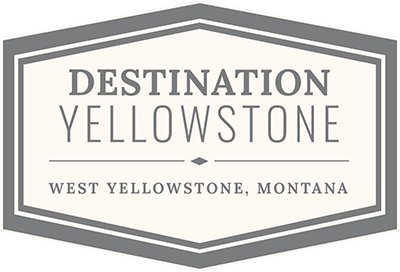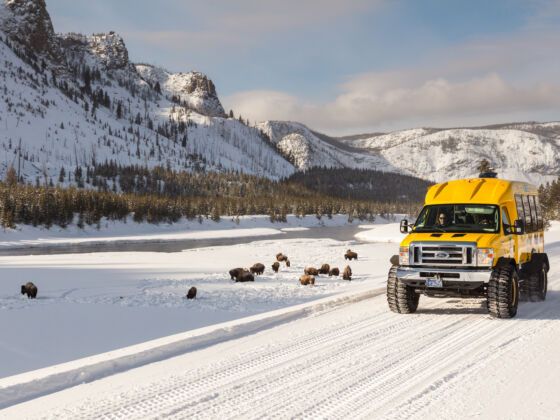The ultimate winter guide to West Yellowstone, MT
Imagine a high, wintery landscape where bison, moose, wolves, and elk roam free. Fresh snowmobiling trails lead to hidden cabins, deep in the firs and spruce of a nearly two-million-acre national forest. Six mountain ranges topping 12,000 feet lend their slopes to a vast network of ski runs and snowshoeing trails, and back in town, the fire is always roaring.
For a winter vacation this supreme, your destination could only be West Yellowstone, Montana. Sitting just outside the western entrance of Yellowstone National Park, the town of West Yellowstone is the region’s ultimate basecamp for winter adventure. Summer crowds gone, the land opens up to all those looking for solitude, adrenaline, and pristine nature.
Of course, this winter it’s essential to explore responsibly and be Montana Aware: check for closures before you head out, have a backup plan just in case, wear your mask, and keep six feet from others at all times. For those ready and willing to respect Montana’s landscapes, its wildlife, and its people, West Yellowstone is the ticket to your greatest winter trip yet. Here’s what’s in store.

Pull up at 100 South Geyser Street in West Yellowstone and you’ll see a wooden archway that reads “Rendezvous Ski Trails.” From here, you can head out on an 18-mile adventure through dense forests of lodgepole pine, open meadows, and rolling hills at 6,800 feet. The trails — open to both snowshoers and Nordic skiers — ripple through Gallatin National Forest, just west of the national park.
The pet-friendly five-mile Boundary Trail is another great trek, roughly paralleling the western border of the park to Baker’s Hole Campground. There’s also the Riverside Trail, a six-mile jaunt following the Madison River. Both are accessible from town and have the potential for a lot of wildlife sightings.
Note: The area ski trails require a daily or seasonal pass, available at the Hebgen Lake Ranger District Office, the West Yellowstone Chamber of Commerce, Freeheel and Wheel (rentals and lessons found here as well), and at the trailhead.
From West Yellowstone, arguably the Snowmobiling Capital of the US, you have access to 400 miles of snowmobile trails. That’s 400 miles blanketed with 150 inches of annual snowfall and surrounded by the Custer-Gallatin, Beaverhead-Deerlodge, and Caribou-Targhee National Forests. Trails spiderweb out from the center of town and straight into the backcountry wilderness.
The 20-mile Madison Arm Loop is suitable for beginners and gives riders stunning views of Hebgen Lake. South Plateau Trail and Horse Butte Loop are of similar length and difficulty, well known for their moose and bison sightings. Two Top Trail, on the other hand, is renowned for its “snow ghosts,” a winter phenomenon involving ice-caked trees. For a more difficult trek, consider the Lionhead Trail, 16 miles of backcountry powder lining the steeps slopes of the Continental Divide.
Note: For rentals and tours, check out this list of local outfitters.
When it comes to resort skiing, it can often feel like you have to pay sky-high prices for sky-high slopes — with inevitably long lines. But not in Southwestern Montana. Here, you’re in the Goldilocks zone: epic downhill skiing, more affordable rates, and wide-open runs without the crowds.
West Yellowstone is basecamp central for all the region’s best slopes, sitting an hour or two away from: Jackson Hole Mountain Resort, Bridger Bowl Ski Area, Big Sky Resort, and Grand Targhee Resort. Big Sky is the second-biggest resort in the nation, with six-mile-long runs across 6,000 acres — and it’s on the Ikon Pass. You could put together the most epic of ski-trip itineraries by mixing a few days at these big-name mountains with time spent back in West Yellowstone and the backcountry powder stashes of the surrounding national forests.
With landscapes this untamed, you’ll know to expect some of the best wildlife spotting of your life. From its serene trumpeter swans to herds of head-turning moose, this corner of Montana is one of the wildest spots in the country.
Your first stop should be the Grizzly & Wolf Discovery Center, a world-class wildlife park caring for bears and wolves (and river otters!) that couldn’t otherwise survive in the wild. Here, you’ll get guaranteed up-close views of — and learn about — these famously elusive creatures.
For a longer, more self-guided adventure, check out the driving route known as “Around the Block,” a 64-mile circuit that incorporates Highways 191, 287, 87, and 20. Across two mountain passes and around three lakes, you’ll watch for bison, mountain goats, moose, osprey, eagles, deer, elk, black bears, antelope, bighorn sheep, coyotes, and foxes. One section of the drive skirts scenic Hebgen Lake, which is famous for wildlife all on its own, including bison, moose, elk, and mountain goats. Birdwatchers might spot herons, sandhill cranes, white pelicans, osprey, loons, and eagles (both bald and golden!).
Say goodbye to the kids begging for Disney World — West Yellowstone is chock-full of activities both the little ones and their adults can enjoy, together. We’re talking ice fishing, downhill sledding, ice skating, snowshoeing, snowcoach rides…the list goes on.
One ultra family-friendly spot is West Yellowstone City Park, just a block from the national park boundary, where the kids can sled or ice skate. Hebgen Lake is great for ice fishing, snowshoeing, and wildlife viewing. When you and the fam are here, you’ll quickly find your favorite spots.
West Yellowstone may be home to fewer than 1,500 residents, but when you’re next door to the world’s first national park, the size of the town isn’t something you tend to place a lot of importance in. And while Yellowstone sees four million visitors a year, those who make the trip in winter get the local amenities pretty much all to themselves.
When it comes to restaurants, look for traditional “Montana” menu items like trout, elk, and bison — and huckleberry! — but don’t be surprised to find plenty of global cuisines here, too. From burgers to fine dining, from your necessary morning latte to take-out for the gang, picky eaters will never have an issue. What’s more, so much of what’s on offer is local. The outfitters, the shops, the tour guides, the cafes…nearly everyone and everything that’s here come winter calls this place home. And when you’re here come winter, it’s that much easier to play, eat, and live like a local.

